Bulletin – June 2015 Financial Stability Structural Features of Australian Residential Mortgage-backed Securities
- Download the article 382KB
Abstract
This article provides a summary of structural features typically found in Australian residential mortgage-backed securities and their evolution over the past decade. Understanding the structural features of the securities is essential to the effective risk management and valuation of the securities because these features determine how the risks of the securitised mortgages are borne by the different investors in the securities.
Introduction
A residential mortgage-backed security (RMBS) is a collection of interrelated bonds that are secured by a dedicated pool of residential mortgages (the ‘mortgage collateral pool’). The payments of principal and interest on these bonds are funded from the payments of principal and interest made on the underlying mortgage collateral by the mortgagors. Historically, RMBS have provided an alternative to bank deposits as a source of funding for residential mortgages. This has been particularly important for smaller authorised deposit-taking institutions (ADIs) and non-ADIs that have limited access to deposit funding or term funding markets. By allowing smaller institutions to raise funding in the capital markets, RMBS promote competition between lenders in the residential mortgage market. After increasing steadily in the early 2000s, issuance of Australian RMBS to third-party investors fell in the wake of the global financial crisis when these securities were adversely affected by a loss of confidence in the asset class globally despite the low level of mortgage defaults in Australia. The market has recovered somewhat over the past couple of years (Graph 1).
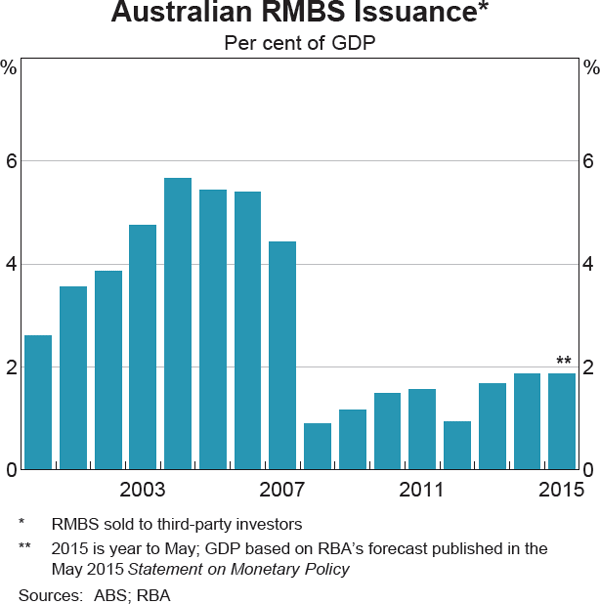
RMBS have been an eligible form of collateral in repurchase agreements (repos) with the RBA since 2007. During the height of the global financial crisis, RMBS formed a significant part of the RBA's repo collateral and hence played an important role in the RBA's response to the crisis (Debelle 2012). Currently, RMBS form the largest class of securities held under the RBA's repos, although unlike the earlier episode, this has been in response to innovations in the payments system (Fraser and Gatty 2014).
From 1 January 2015, the RBA has provided a Committed Liquidity Facility (CLF) to eligible ADIs as part of Australia's implementation of the Basel III liquidity standards. In total, the CLF provides ADIs with a contractual commitment to $275 billion of funding under repos with the RBA, subject to certain conditions.[1] Given that RMBS are eligible collateral that could be provided to the RBA were the CLF to be utilised, they represent a substantial contingent exposure for the RBA and, hence, understanding RMBS is particularly important in terms of managing the RBA's balance sheet.
While discussions of RMBS often focus on the mortgage collateral pool, as all payments to investors are made from the cash flows generated from this pool, the structural features of RMBS play an equally important part in determining the risks facing the holders of these securities. The ‘structure’ of an RMBS refers to the number and size of the interrelated bonds of the RMBS, the rules that determine how payments are made on these bonds and various facilities that support these payments.
This article provides a summary of the structural features typically found in Australian RMBS and how these have evolved over the past decade.[2]
Overview of RMBS Structures
When an RMBS is issued, the economic interest in the mortgages in the collateral pool is transferred from the RMBS ‘sponsor’ to a newly established bankruptcy-remote legal entity (the ‘RMBS trust’).[3] The mortgage collateral pool, together with bank accounts used to temporarily store payments made on these mortgages, constitute the majority of the assets of the RMBS trust. (A schematic description of the cash flows in an RMBS is provided in Figure 1 and the structural features shown there are discussed in detail throughout the rest of this article.) The RMBS trust issues a number of bonds (‘notes’), each with its own unique characteristics, to raise the funds necessary to purchase the economic interest in the mortgages from the sponsor. The notes, together with payment obligations to the various external parties that provide services to the trust, constitute the liabilities of the RMBS trust. Over time, as repayments are made on the mortgages, the funds received by the trust are used to pay interest due on the notes and to gradually repay (amortise) the notes' outstanding principal. Credit risks and risks regarding the timing of payments originate in the mortgage collateral pool, but are reshaped by the RMBS structure that is used to distribute the payments and losses to the notes. The rules that govern these distributions are documented when the RMBS is issued.
Payments of interest and principal, and allocations of losses, to the RMBS notes are made at regular intervals (typically monthly) on preset ‘payment dates’. The payments in a given period are made out of funds received from the mortgage pool during the most recently ended ‘collection period’, which typically runs over the preceding month. The rules that determine how the payments of interest and principal are made to the notes, and how losses are allocated to the notes, are referred to as the RMBS ‘cash flow waterfall’ (waterfall). In practice, each RMBS has three separate, but interacting, sub-waterfalls: the ‘income waterfall’; the ‘principal waterfall’; and the ‘chargeoff waterfall’.[4] The trust manager calculates on the ‘determination date’ the payments to be made to the notes and how any losses are to be allocated to the notes following the rules set out in these waterfalls.[5]
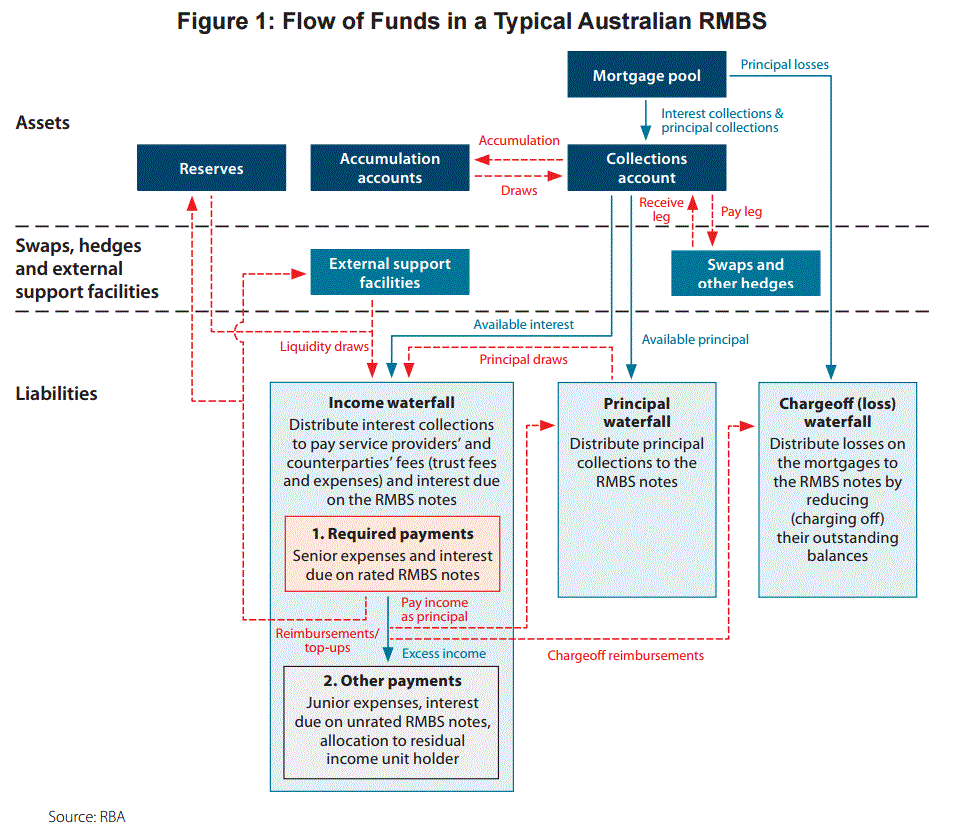
In an RMBS, the collections from the mortgage pool, less any redraws, are deposited in a bank account called the ‘collections account’.[6] The need to store the collections in a bank account arises because payments on the RMBS notes are generally made monthly, while payments on the mortgages occur daily throughout the preceding collection period.
Australian RMBS often face an asset-liability mismatch because the payments by borrowers on the mortgages have different characteristics from the payments on the RMBS notes. For example, collections from Australian residential mortgages are in Australian dollars, while some of the notes may be denominated in a foreign currency. Swaps with third parties are used to reduce asset-liability mismatches by modifying some of the funds in the collection account (see ‘Transforming Cash Flows’ section).
Once the collections are modified, they are split into separate ‘available income’ and ‘available principal’ components, which are then paid out separately as interest and principal to the RMBS notes. The rules that specify how the available income is distributed to the notes are defined in the income waterfall, and the rules for the distribution of available principal are defined in the principal waterfall.[7] Any principal losses on the mortgages are allocated to the RMBS notes following the rules in the chargeoff waterfall (see ‘Tranching’ section).[8]
In the income waterfall, the available income is first used to make the payments of: the trust's expenses; the fees due to the various counterparties of the RMBS trust; and the interest due on the rated RMBS notes (these payments are collectively referred to as the ‘required payments’).[9] An inability of the RMBS trust to meet some of the required payments results in an event of default. Hence, to minimise this risk and to obtain credit ratings on the RMBS notes, Australian RMBS use a number of structural features to support the full and timely payment of the required payments (see ‘ Liquidity Support’ section). While some of this support is provided by external counterparties for a fee in the form of ‘liquidity support’ facilities, some of it is also provided internally through reserves and the interaction between the sub-waterfalls.
There are other interactions between the sub-waterfalls that may redirect available income that remains after the required payments have been made (referred to as ‘excess income’) to the principal and chargeoff waterfalls or to the liquidity support facilities and reserve accounts (see ‘Use of Excess Income’ section).
The principal waterfalls of Australian RMBS have changed significantly in recent years as discussed in the ‘Tranching’ and ‘Allocation of Principal’ sections. The structures of Australian RMBS can be dynamic because the rules that distribute the interest, principal and chargeoffs to the notes may change over time in predefined ways based on the performance of the RMBS (see ‘ Allocation of Principal’ section), and in some limited cases new notes may be issued (see ‘Other Features’).
Tranching
The key feature of RMBS structures is ‘tranching’, which transforms the mortgage pool into a range of securities (the RMBS notes), each with a different risk and maturity profile.
While historically Australian residential mortgages have experienced low default and loss rates (Debelle 2010), they nonetheless carry credit risk. Given the expected losses on a residential mortgage portfolio, securities backed by such a portfolio without some form of credit support to reduce the expected losses would not appeal to most fixed-income investors. Moreover, the typical Australian residential mortgage has a legal maturity of around 30 years, which is much longer than the usual investment horizon for fixed-income investors. In addition, the actual repayment behaviour is uncertain, largely reflecting the borrower's option to repay the mortgage, in part or in full, ahead of its legal maturity.
In an RMBS, principal payments and losses generated from its mortgage pool are tranched across credit and time dimensions to determine how these two risks are borne by the various notes in the RMBS. Tranching establishes the relative order in which the RMBS notes receive principal payments and are allocated losses, by designating each note to be either junior or senior to another note in the principal and chargeoff waterfalls. Groups of notes within the same RMBS can also have equal seniority, in which case they are allocated principal and/or chargeoffs in proportion of their outstanding amounts.
Through credit tranching, losses arising from the underlying pool are distributed first to the most ‘junior’ note outstanding until its principal is fully charged off, then to the next most junior note outstanding until its principal is fully charged off, and so on until losses are fully allocated to the RMBS notes (Graph 2).[10] In this way, a senior note is protected from taking any losses until all of its junior notes are fully charged off; the junior note is said to provide ‘credit enhancement’ to the senior note through the junior note's credit subordination. The size of the credit enhancement to an RMBS note is measured by the size of the outstanding balance of its subordinated notes as a percentage of the aggregate outstanding balance of all notes.
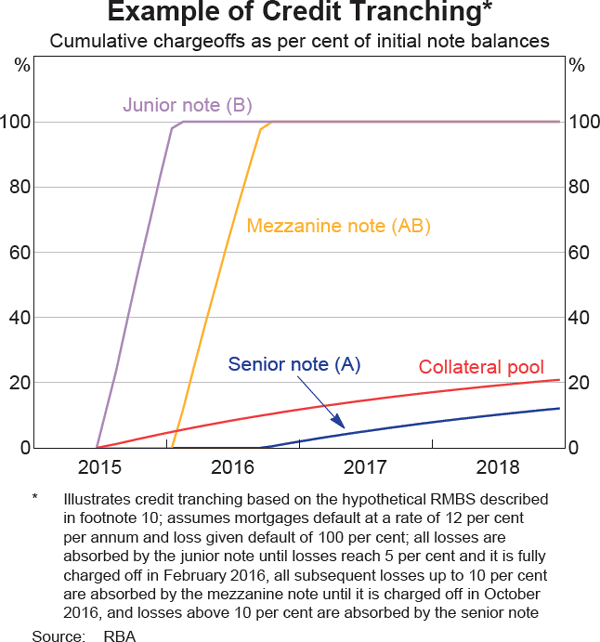
As a result of credit tranching, RMBS can be structured to have senior notes with much lower credit risk than the credit risk of the underlying mortgage pool by concentrating the credit risk in the junior notes. The reduction in credit risk achieved by the senior note depends on the size of its subordinated junior notes (and any external forms of credit support).[11] The credit enhancement provided by the junior notes to the most senior notes in Australian RMBS has generally increased since 2008. For banks there has been a fourfold increase, with the size of the credit-subordinated notes as a share of all notes increasing from 2 per cent in 2005 to 8 per cent in 2015, while the increase for RMBS issued by credit unions and building societies (CUBS) and non-ADIs has been around twofold (Graph 3).
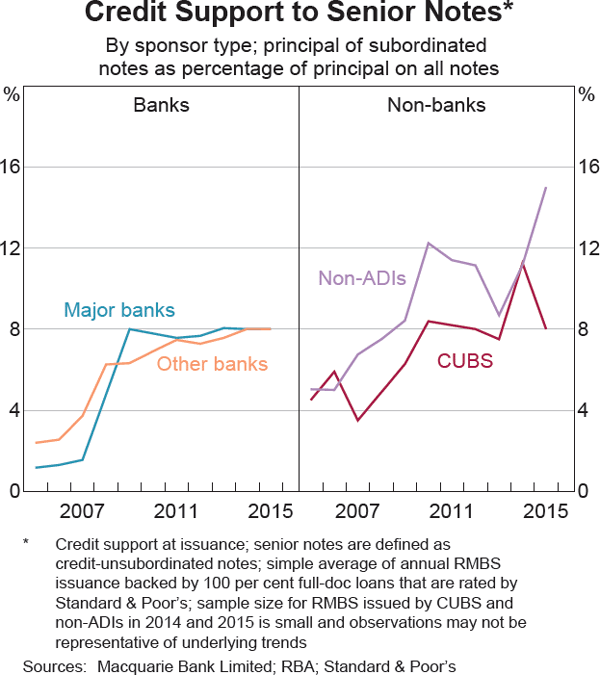
Australian RMBS are structured to provide a level of credit enhancement sufficient for the most senior note to obtain a AAA credit rating. Some RMBS notes can be ‘mezzanine’ in that they are both junior to some notes and senior to others. Mezzanine notes can achieve a AAA rating just like senior notes; however, they ultimately have different credit risk characteristics.[12] Since 2013, the senior notes in ADI-sponsored RMBS have had at issuance around 8 per cent credit enhancement from subordinated notes, compared with around 3 per cent for mezzanine notes (Graph 4). The level of credit enhancement provided for RMBS sponsored by non-ADIs is higher, with 10 per cent and 4 per cent credit enhancement provided for the senior andmezzanine notes, respectively; this reflects the relatively riskier characteristics of the mortgages typically originated by non-ADIs.
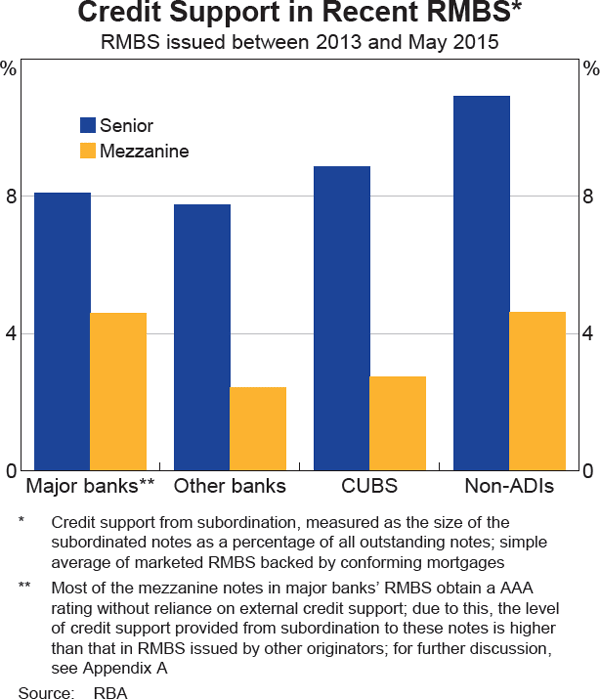
Through time tranching, principal repayments from the underlying mortgage pool are directed first to pay the outstanding principal on some of the notes before they can be allocated to repay the outstanding principal on the rest of the notes. Often the notes receiving principal payments first are the senior notes created by the credit tranching, although since 2008 Australian RMBS have evolved more complex time tranching mechanisms that are discussed in more detail in the ‘Allocation of Principal’ section. While a typical Australian RMBS pool has an average contractual maturity of around 30 years, reflecting the features of the underlying mortgages, senior RMBS notes, through time tranching, are expected to be fully repaid within 10 years.[13] Time tranching is an important influence on the weighted average life (WAL) of the notes (a concept of duration commonly used for RMBS).[14] Reflecting time tranching, the senior notes in Australian RMBS issued since 2011 have had a WAL of 3 years at issuance, while the junior notes have had a WAL of 5.3 years at issuance (Graph 5). For comparison, the WAL of a pool of Australian mortgages is expected to be around 3.8 years.[15]
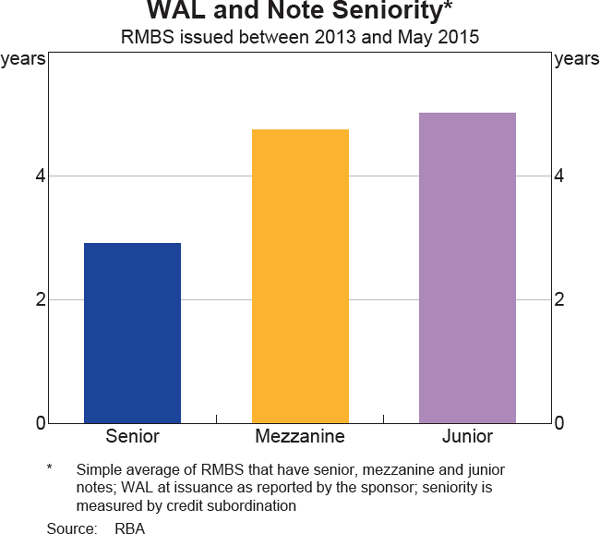
Time tranching also affects a note's sensitivity to prepayment risk, which arises from variation in the rate at which mortgages in the collateral pool are prepaid. Under normal market conditions, when the senior notes are not expected to experience credit losses, the market practice is to value the senior RMBS notes based on their expected WAL, which depends on expected prepayments. Any variations from the expected prepayments of mortgage principal, which is measured by the conditional prepayment rate (CPR), leads to variations in the WAL and, hence, the valuation of the RMBS notes.[16] The WAL of senior notes exhibits significantly smaller sensitivity than the WAL of junior notes to variations in the prepayment rate (Graph 6).
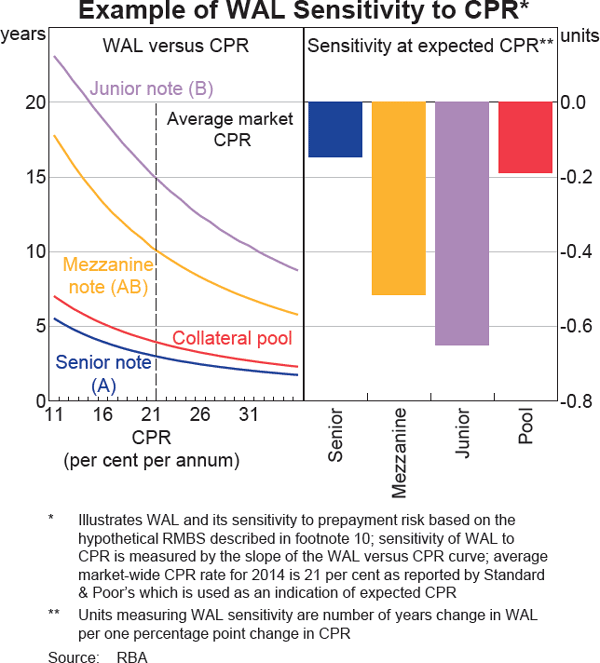
For a given CPR, the WAL of the senior notes is lower than the WAL of the collateral pool and, conversely, the WAL of the junior notes is higher than the WAL of the pool. Moreover, at a given CPR, the WAL of a senior note changes by less than the WAL of a junior note for a given change in the CPR.
Since the junior notes do not receive any principal payments until the senior notes are fully amortised, the relative size of junior notes increases over time. As a result, there is a gradual increase in the loss level as a share of the outstanding mortgage pool that can be absorbed by the junior notes before losses begin to affect the senior notes. Therefore, time tranching, in combination with credit tranching, reduces over time the credit risk of the senior notes.
In summary, tranching enhances one part of the RMBS liability structure at the expense of another, by reducing credit and prepayment risk on the senior notes, while increasing these risks for the junior notes. Since 2005, there has been an increase in the degree of tranching in Australian RMBS. The average number of notes in an RMBS has increased from three in 2005 to four in 2015, with most of the increase occurring after 2008 (Graph 7). The increase has been concentrated in the junior notes (which are typically rated below AAA), with the average number of such notes increasing by 1.5 per RMBS. The increase has been more pronounced in RMBS issued by non-ADIs. The higher number of tranches for RMBS issued by non-ADIs reflects the need for non-ADI sponsors to fund their mortgage lending fully through RMBS issuance. This has led RMBS issued by non-ADIs to be structured with a larger number of tranches with different characteristics that appeal to a broad range of investor risk appetites.

Liquidity Support
A key consideration in the structuring of Australian RMBS is to ensure the timely and full payments of the required payments in the income waterfall. When the risk of missing required payments arises from temporary factors, it is a form of liquidity risk rather than credit risk.
There are two main sources of this liquidity risk. The first is that Australian RMBS typically have a longer accrual period on the first interest payment due on the notes relative to the length of the first collection period.[17] The other is that delinquent borrowers make no interest payments, thus reducing the interest paid on the mortgage pool. This is a problem as the interest due on the notes is calculated on the outstanding amount of the notes, which is only reduced after defaulting mortgages are eventually foreclosed.
Australian RMBS use a number of facilities (or reserves) and internal structural features to provide temporary support to manage the risk of having insufficient available income to meet required payments.
The first mitigant is an interaction between the principal and income waterfalls through the ‘principal draw’, which redirects some of the principal collections away from the principal waterfall towards making the required payments in the income waterfall. Principal draws, which are effectively a borrowing from the principal waterfall, must be reimbursed eventually from the excess income in the income waterfall in subsequent periods. Principal draws are ubiquitous and have been present in all RMBS issued since 2013 (Table 1). The size of the liquidity support provided by the principal draw depends on the prepayment behaviour of the borrowers in the mortgage pool, as it is limited to the principal repayments received during the collection period, and is equivalent to around 2 per cent per month of the size of the pool (based on current prepayment rates).
| Prevalence | Average Size | Range | |
|---|---|---|---|
| Per cent of RMBS | Per cent of collateral pool | Per cent of collateral pool | |
| Principal draw(a) | 100 | 2.0 | 1.5–2.1 |
| Liquidity facility(b) | 73 | 1.9 | 0.8–4.0 |
| Liquidity reserve(b) | 30 | 1.3 | 0.8–2.3 |
| Threshold rate mechanism | 100 | Unlimited(c) | na |
|
(a) Size of the liquidity support provided from the principal draw is estimated from
the average market-wide monthly CPR for Australian RMBS between 2013
and 2015 as reported in Standard & Poor's (2015), with the range
estimated from the maximum and minimum market-wide average CPR observations
during this period Sources: RBA; Standard & Poor's |
|||
The second mitigant, which is typically used only when the principal draw is insufficient, is a dedicated ‘liquidity facility’ or a ‘liquidity reserve’. A liquidity facility is a line of credit provided to the RMBS trust for a fee. A liquidity reserve, which serves the same role as a liquidity facility, is an account held by the RMBS trust. A liquidity reserve can either be: funded upfront by the sponsor; funded by the issuance of notes to a value exceeding the value of the mortgage pool; or gradually built up through an accumulation of excess income. After being drawn, liquidity facilities and reserves are eventually repaid or topped up through excess income in future periods.[18] Liquidity facilities have been more prevalent than liquidity reserves in recently issued RMBS since 2013, reflecting the larger share of RMBS issuance by the major banks which tend to use liquidity facilities given their financial strength. The size of the liquidity support provided from liquidity facilities is slightly larger than from reserves.
The final mitigant, and the one that provides the strongest protection against liquidity risk, is the ‘threshold rate mechanism’. A threshold rate mechanism is an agreement between the RMBS trust and the ‘mortgage servicer’ that requires the mortgage servicer to set at each point in time the interest rate charged on the variable-rate mortgages in the mortgage collateral pool to a level that is sufficient to generate enough available income to meet the required payments.[19] This has been a standard structural feature of Australian RMBS. For example, all RMBS issued since 2013 have a threshold rate mechanism. However, the threshold rate mechanism has two major drawbacks. First, to meet the obligations under the threshold rate mechanism, the mortgage originator may have to ultimately raise its standard variable rate, which affects all mortgages originated by the mortgage originator, not just the mortgages in the collateral pool of the particular RMBS experiencing liquidity stress. Second, an increase in the rate paid by the mortgages in the pool above comparable market rates may lead to good quality borrowers refinancing their mortgages with another lender, leaving the mortgage pool more concentrated in low quality borrowers who have been unable to refinance.
Australian RMBS typically have liquidity support arrangements that can meet required monthly payments equivalent to around 4 per cent of the size of the outstanding notes before there is a need to invoke the threshold rate mechanism. As such, the use of threshold rate mechanisms is very unlikely in an environment of low delinquency rates on securitised mortgages.
Transforming Cash Flows
In order to appeal to fixed-income investors, Australian RMBS notes pay regular coupons based on capital market conventions, either as a fixed margin added to a short-term interest rate benchmark (typically the comparable maturity bank bill swap rate (BBSW)) or as a fixed rate, and may include notes denominated in foreign currencies. However, the interest payments on the mortgage assets do not follow the same capital market conventions and interest and principal payments are made in Australian dollars. These asset-liability mismatches create a risk that the RMBS trust may not be able to meet payments due on its liabilities because of adverse movements in interest rates or exchange rates. These risks are managed through interest rate swaps and foreign exchange swaps, which are tailored to meet the specific requirements of individual RMBS.
Australian RMBS mortgage pools contain both fixed-and variable-rate mortgages, though generally most securitised mortgages pay a variable rate set by the mortgage originator (i.e. the originator's standard variable rate less any discount offered to the borrower). As a result, typically the interest payments received from the mortgage pool are determined by the standard variable rate, while the interest payments on the liabilities are determined by the BBSW. While the standard variable rate and BBSW move approximately in line with each other, there may be situations where the basis between the two rates (i.e. the difference between the standard variable rate and BBSW) varies significantly. This basis risk needs to be managed effectively in all Australian RMBS.
Some RMBS manage the basis risk through ‘basis swaps’, where the interest payments on the variable rate mortgages are swapped for a payment of BBSW plus a margin. Basis swaps are typically provided by the RMBS sponsor because they are non-standard swap contracts that are relatively large and difficult to hedge. Moreover, the variable rate on the mortgage pool that determines one leg of the basis swap payments is set by the mortgage originator, which is often the sponsor of the RMBS. This limits the ability of counterparties other than the originator to provide the swap. In recent years, basis swaps have been used in all RMBS issued by the major banks and most of the RMBS issued by other banks, reflecting the fact that these institutions have the financial strength to be credible counterparties (Graph 8). RMBS issued by CUBS are less likely to feature basis swaps, and RMBS issued by non-ADIs have not used basis swaps in their structure.[20]
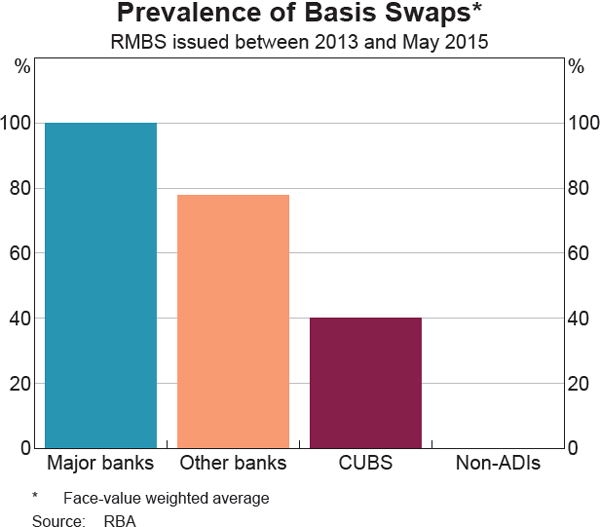
Besides managing the basis risk, the basis swap allows the RMBS originator to prevent the triggering of the threshold rate mechanism that would require it to increase its standard variable rate above the prevailing market level, reducing its competitiveness. In this way, the basis swap is a structural feature that not only enhances the RMBS, but also benefits the mortgage originator.
Australian RMBS face interest rate risk from the fixed-rate mortgages in the mortgage pool because the BBSW rate may rise relative to the rate received on these mortgages. Conversely, RMBS with fixed-rate notes face the risk that the interest rate on the variable-rate mortgages in the pool may decline relative to the fixed rate on the notes. Fixed-for-floating interest rate swaps are commonly used to manage this interest rate risk. Similarly, cross-currency swaps are used to hedge the foreign exchange rate risk in RMBS with notes denominated in a foreign currency. These swaps are tailored to the RMBS market by having a notional amount amortising in line with the mortgage pool. While the basis risk in an Australian RMBS is relatively low because the standard variable rate and BBSW rates tend to move closely together, the interest rate risk (and the foreign exchange rate risk when present) may be significant. The swaps used to hedge these risks expose the RMBS to counterparty risk, that is the risk that the swap provider defaults. The counterparty risk is managed by requiring the swap counterparty to post collateral to the RMBS trust when the counterparty's credit rating declines below a particular level, and to find a replacement counterparty when its rating falls below a second, lower level.[21]
Use of Excess Income
For an RMBS to be economically viable, the available income expected to be received from the mortgage pool must be no lower than the interest expected to be paid to the notes and the RMBS expenses. In the income waterfall, available income remaining after the required payments have been made represents excess income, which is used to support some of the key structural features of the RMBS. Uses of excess income include:
- support to the liquidity facilities by reimbursing previous draws on the facilities, including principal draws
- the build-up of internal RMBS reserves that can provide additional credit and liquidity enhancements to the RMBS notes
- the reimbursement of chargeoffs on the notes, thus reducing losses from mortgage defaults
- the acceleration of the repayment of principal on the notes.
Any excess income left after making such distributions is paid to the ‘residual income unit holder’, which is usually the RMBS sponsor.
Allocation of Principal
Because credit and time tranching concentrate the credit and prepayment risk in the junior notes, RMBS investors require a higher compensation for these risks in the form of receiving a higher margin over BBSW on the junior notes relative to the senior notes. Through time tranching, the lower-yielding senior notes amortise first, leading to an increase in the proportion of the higher-yielding junior notes over time and an increase in the yield payable on the RMBS liabilities. In contrast, the yield that is received from the mortgage pool remains the same over time (abstracting from any changes in interest rate levels). The compression between the yield payable on the liabilities and the yield received from the mortgage pool (known as yield strain) makes meeting the required payments in an RMBS more difficult over time.
In Australian RMBS, there are two typical approaches to the allocation of principal collections to the notes – ‘sequential paydown’ and ‘serial paydown’. Under sequential paydown, principal collections are allocated to the most senior note outstanding. Under serial paydown, principal collections are allocated to all notes in proportion to their outstanding principal balances. Sequential paydown represents a strict application of time tranching. However, because this results in yield strain, sequential paydown is often used to distribute principal in the first few years after the issuance of an RMBS, with the principal allocation switching to serial paydown usually two to four years after the issuance of the RMBS (Graph 9).
Unlike sequential paydown of principal, which builds up credit enhancement over time (see ‘Tranching’ section), serial paydown limits yield strain but also limits the build-up of credit enhancement and lengthens the WAL of the senior notes (Graph 10).
Given this, the switch from sequential to serial paydown only occurs when a number of conditions are satisfied, with these conditions designed to ensure that the use of serial paydown does not materially increase the credit risk of the senior notes.[22] These conditions typically require that:
- a minimum length of time has elapsed since the issuance of the RMBS
- the level of credit enhancement of the senior notes has increased since the RMBS issue date to be above a minimum level
- delinquencies in the mortgage pool are low
- there are no outstanding chargeoffs on the notes
- there are no unreimbursed draws on liquidity facilities, including the principal draw.
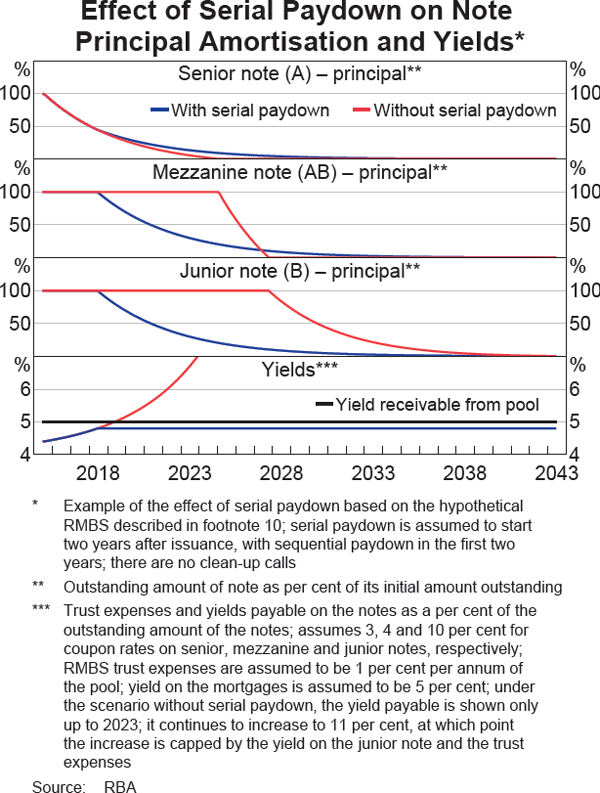
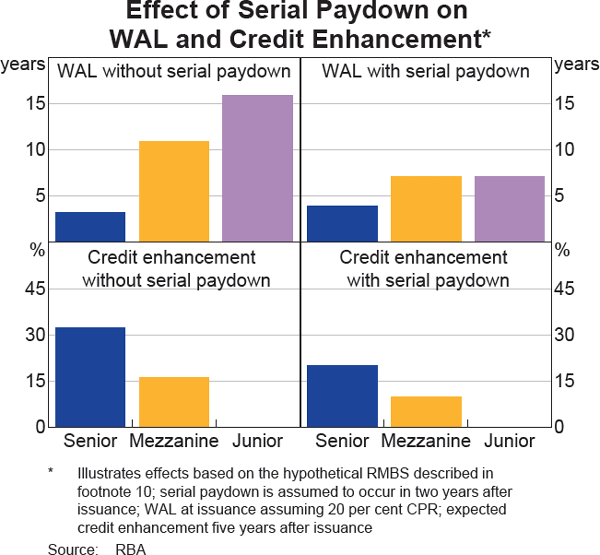
The spread between senior and junior note margins in Australian RMBS has widened significantly since the global financial crisis, increasing the risk of yield strain. This has led to a more widespread use of serial paydown since 2008 (Graph 11). Another factor contributing to the increased use of serial paydown, particularly in RMBS issued by ADIs, was the revision of the Australian Prudential Regulation Authority's (APRA) Prudential Standard APS 120 Securitisation (APS 120) in 2010 that clarified the applicability of the 20 per cent limit on an ADI's holdings of the notes in an RMBS sponsored by the ADI (for details, see APRA (2010)). A sponsoring ADI may hold some proportion of the junior notes in an RMBS it sponsors, and the share of these notes will increase over time through the sequential paydown of principal. By structuring the RMBS to include a serial paydown, the share of the junior notes can be capped, thereby assisting the ADI in meeting the 20 per cent holding limit under APS 120 (Moody's 2010).[23]
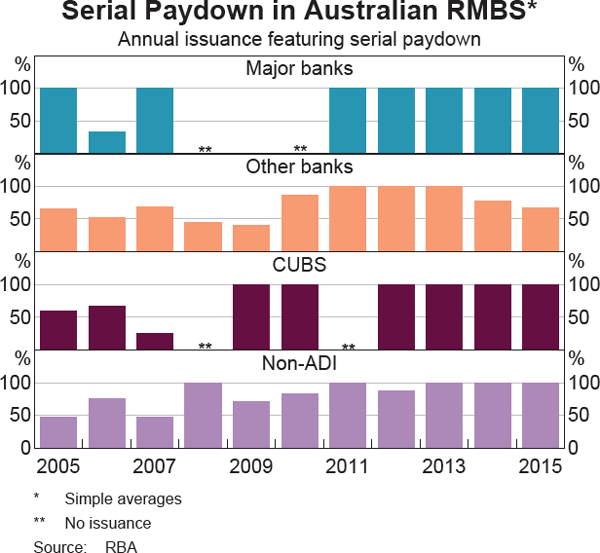
Other Features
Clean-up calls
The clean-up call option is the most prominent example of a discretionary trigger. It has become a standard feature of Australian RMBS that allows the RMBS sponsor to buy back all of the outstanding notes when certain conditions are met. Typically, clean-up calls can be exercised when the outstanding mortgage pool balance falls below a certain proportion (often 10 per cent) of its initial value, and in the case of non-ADI RMBS, a clean-up call can be exercised after a certain date.[24]
Clean-up calls provide investors with more certainty around the WAL of the notes. This is particularly important for the junior notes as the expected final maturity of a junior note will increase to the contractual maturity of the mortgages (typically 30 years) if the clean-up call option is not exercised.
Furthermore, as the mortgage pool amortises it may become uneconomical to run the RMBS as the fixed administration costs rise relative to the income generated from the mortgages. The exercise of the clean-up call, after the relevant triggers have been satisfied, is at the option of the sponsor as the sponsor needs to fund the purchase of the mortgage pool (which often occurs through repackaging the mortgage pool into a new RMBS) and is effectively conditional on prevailing market conditions.
Typically, RMBS issued before the global financial crisis included clean-up calls (Graph 12). As funding conditions tightened, especially in the RMBS market, the inclusion of clean-up calls in RMBS issued between 2007 and 2010 declined significantly for RMBS not sponsored by the major banks. As conditions improved, clean-up calls returned as a typical structural feature of Australian RMBS issued by all sponsor types since 2011.
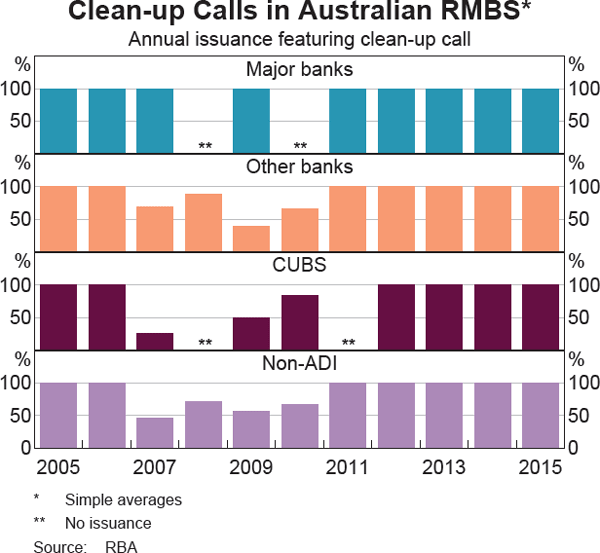
Bullet notes
The majority of Australian RMBS notes are fully amortising ‘pass-through’ securities, where all the principal payments from the mortgage pool during a collection period are distributed to the notes.
In recent years, some RMBS have been structured with one or more bullet notes, where the principal on the bullet note does not amortise but is instead repaid on the note's maturity date. Bullet notes are of interest owing to: investor demand for more certainty in the timing of principal payments; and the lower cost of hedging interest rate or foreign exchange risk when there is certainty around the timing of principal payments. Bullet notes are structured either as ‘hard bullets’ or ‘soft bullets’. Hard bullets must be repaid in full at their maturity, while for a soft bullet, an RMBS trust has the option to convert the security into a pass-through note with the coupon increasing by a predefined margin.[25] Often bullet principal is repaid by the issuance of a ‘refinance note’. However, the successful issuance of such notes depends on market conditions. The refinancing risk of a hard bullet is managed through a ‘redemption facility’, whereby a third party agrees to fund the principal repayment on the hard bullet if this cannot be financed in the market. For the RMBS trust, the refinance risk of a soft bullet is limited to the step-up margin; however, investors in soft bullets face the risk of a delay in the return of principal (extension risk).[26]
The repayment of principal on bullet notes may also be partially or fully made from mortgage payments that have been gradually accumulated in a dedicated account over the life of the bullet; however, such accounts have a lower yield than the RMBS notes, which adds to yield strain. As a result of the refinancing risk of bullets, their use has been relatively limited. While bullet notes have become more common in Australian RMBS, and have been included in around 20 per cent of the RMBS issued since 2010, the relative size of the bullet notes has been quite small (Graph 13). Over this period, foreign currency-denominated RMBS notes have been exclusively structured as bullet notes, and such notes have been mainly used in non-ADI RMBS to access a broader investor base.
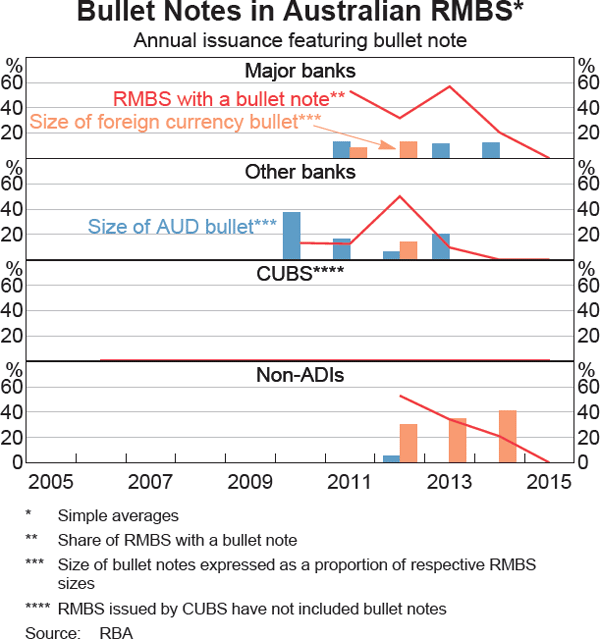
Conclusion
The structures of Australian RMBS have evolved over time. Australian RMBS have generally become more structured over the past 10 years, especially since the global financial crisis: the tranching of both credit and prepayment risk has increased; the use of principal allocation mechanisms that vary over the life of the RMBS has become more widespread; bullet notes have been added; and various external and internal support facilities have continued to be used. The increased structuring, which has developed to address changing market conditions, does not necessarily create more risk for investors, especially if they are provided with transparent and complete information about RMBS structures. Indeed, there has been a significant increase in the size of the credit enhancement provided to the most senior notes through the subordination of junior notes, with the increase in excess of the requirements of the credit rating agencies. The reliance on external credit support from LMI has also declined.
Understanding RMBS structures is essential to the effective risk management and valuation of RMBS because the RMBS structure determines how the risks generated from the securitised mortgages are borne by each particular RMBS note. Given the importance of RMBS as collateral in the RBA's repurchase agreements, the RBA has a keen interest in understanding RMBS structures. The RBA's reporting requirements for repo-eligible asset-backed securities, which come in effect from 30 June 2015, will provide standardised and detailed information, not only on the mortgages backing RMBS, but also on the RMBS structures, including their cash flow waterfalls.
Appendix A: Australian RMBS and Lenders Mortgage Insurance
Lenders mortgage insurance (LMI) is a type of insurance policy that covers the losses from a default on a (residential) mortgage that remain after the sale of the collateral property.[27] After credit tranching, LMI on the mortgage pool is the main type of credit enhancement used in Australian RMBS. However, the credit enhancement provided by LMI is different from that of credit tranching, as it relies on the LMI provider's willingness and ability to pay under the terms of the policy, and is limited by the financial strength of the LMI provider. The credit ratings agencies take into account the losses on the mortgages pool that are expected to be covered by LMI when determining the minimum credit enhancement required for a note to achieve a particular rating. In this way, more extensive LMI coverage of the mortgage pool results in a lower required minimum credit enhancement.
Prior to 2007, market confidence in LMI was high and it was standard for Australian RMBS mortgage pools to be 100 per cent covered by LMI (Graph A1). Taking advantage of the extensive LMI coverage, the typical RMBS issued before 2008 had at least one senior note that obtained its AAA rating based on reliance on LMI; that is, the credit enhancement provided to the note by more junior notes was below the level of credit enhancement that the credit ratings agencies would have required if none of the mortgages had LMI (Graph A2).
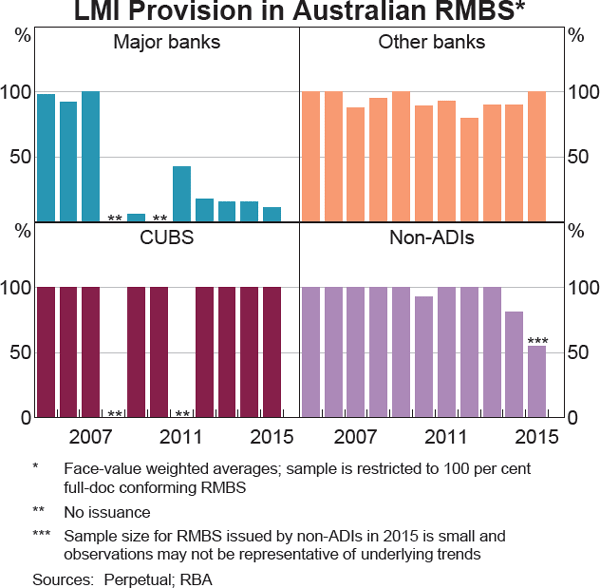
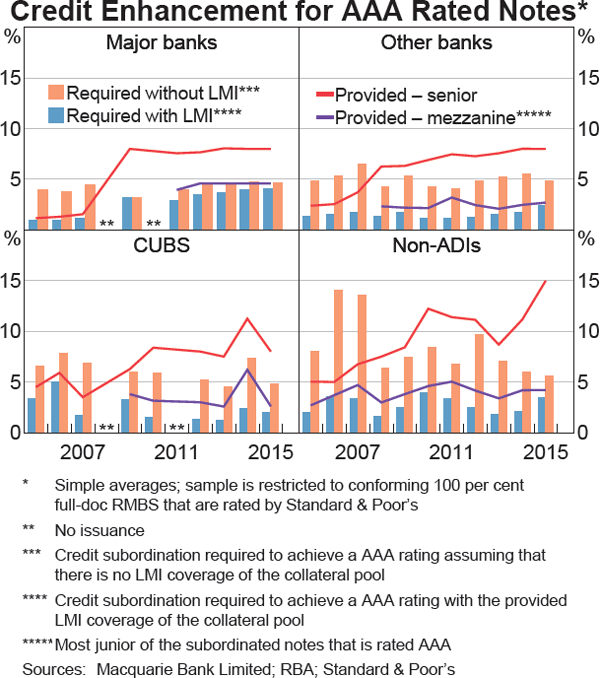
However, during the global financial crisis, market confidence in many forms of external credit support, including LMI, declined (RBA 2008; Moody's 2011). Since 2008, the credit rating agencies have reduced the benefit they assign to LMI coverage when assessing RMBS ratings and the credit ratings of the major LMI providers have been lowered. As a result, reliance on LMI as a form of credit enhancement has declined. In RMBS issued by the banks, the level of credit enhancement provided by the junior notes to the most senior AAA-rated notes has increased fourfold to above the level required for a AAA rating without any LMI coverage. This has delinked the AAA ratings on the most senior notes in bank-issued RMBS from the credit quality of the LMI provider. Similarly, the credit enhancement of the most senior notes in RMBS issued by CUBS and non-ADIs has increased to be above the level required for a AAA rating without LMI coverage. Consequently, the most senior notes in these RMBS have also had their ratings delinked from LMI. RMBS issued by banks since 2011 have often included a mezzanine AAA-rated note, whose rating has been delinked from LMI for the major banks' RMBS but has been LMI dependent for the smaller banks. RMBS issued by the CUBS have typically featured such LMI-dependent AAA-rated LMI notes since 2009, while non-ADI RMBS have been structured with such mezzanine notes since before the global financial crisis. Therefore, while reliance on LMI has declined in Australian RMBS for the most senior notes since 2008, RMBS issued by smaller banks, CUBS and non-ADIs have continued to be structured with some reliance on LMI.
Reflecting these developments, major banks' RMBS have significantly reduced LMI coverage of their RMBS mortgage pools, with LMI coverage now limited to mortgages with higher loan-to-valuation ratios (i.e. an LVR over 80 per cent).[28] In contrast, LMI coverage of the mortgage pools in RMBS issued by other banks, CUBS and non-ADIs has declined only a little relative to pre-2007 levels. Furthermore, the demand by some Australian ADIs for LMI coverage of their residential mortgages has been diminishing in recent years, partly due to regulatory changes (Moody's 2014). This has been another factor contributing to the decline in the share of securitised mortgages covered by LMI, particularly in RMBS originated by the major banks.
Footnotes
In Song Kim and Karl Stacey are from Domestic Markets Department, and Ivailo Arsov is from Economic Analysis Department but completed this work while in Domestic Markets Department. The article has benefited from valuable comments and discussions with David Wakeling and Ellana Brand (both are from Domestic Markets Department). [*]
For further discussion of the CLF, see Debelle (2011). [1]
The focus of this article is on the structural features of marketed RMBS, which are issued to third-party investors. Self-securitised RMBS are retained entirely by the issuing ADI as a form of collateral to be used in repos with the RBA in order to access central bank liquidity (for further information, see Debelle (2012)). The structural features of self-securitised RMBS are effectively the same as the structural features of marketed RMBS, except that most self-securitised RMBS have a revolving mortgage collateral pool. This allows, during a specific period of time, for the accumulated principal repayments from the mortgage pool, instead of being used to make the principal repayments to the RMBS bonds, to be used to purchase additional mortgages that are added to the pool. In these RMBS, the purchase of additional mortgages can also be funded by issuing additional RMBS bonds. [2]
In the event that the RMBS trust defaults on payments that are due, the note holders (and other creditors) have recourse to the assets of the trust but not to the sponsor. Similarly, in the event of default by the sponsor, its creditors have no recourse to the mortgage collateral pool of the RMBS. Hence, the RMBS trust is bankruptcy-remote from the sponsor. [3]
RMBS also have a ‘default waterfall’. This sub-waterfall sets out the rules on how payments are distributed in the event of default by the RMBS trust. This is distinct from how losses from defaults in the mortgage collateral pool are distributed, which is governed by the chargeoff waterfall. As a large number of the RMBS structural features are designed to prevent a trust default, the default waterfall is expected to be used very infrequently to distribute payments. Following an event of default, a meeting of the secured creditors (this would typically include swap and facility providers and note holders) must be called to vote by extraordinary resolution on the next course of action. Generally, secured creditors' voting rights are proportional to the amount owed to them by the trust. [4]
The determination date is after the end of the relevant collection period and typically a few days before the corresponding payment date. [5]
Australian mortgagors often have an option to make redraws from the principal that they have prepaid. Since principal prepayments are not retained by the trust, but are instead passed through to the notes, there is a need for the RMBS trust to fund redraws. In most cases, principal collections (which are yet to be transferred to the note holders) during a period are sufficient to cover redraws during the same period, leading to a net positive principal collection. However there may be situations where redraws exceed principal collections. To deal with this situation, RMBS often have ‘redraw facilities’ or ‘redraw reserves’ in order to fund negative net principal repayments from the mortgage pool; these can also be funded through the issuance of new notes (redraw notes). [6]
The depiction of the swaps in Figure 1 outside of the sub-waterfalls is for illustration only. In practice, net payments from the RMBS trust to its swap counterparties are generally made within the sub-waterfalls, while net receipts from the swap counterparties generally occur before the distributions are made in the sub-waterfalls. [7]
The charged off amount of a note represents the part of a note's principal that will crystallise into a loss of principal for the investor if the chargeoff is not reimbursed before the final maturity of the RMBS. [8]
Some of the RMBS notes receive a credit rating, these are the rated notes; some notes may not receive a credit rating, these notes are the unrated notes. [9]
Some of the key structural features discussed in this article are illustrated with a hypothetical RMBS that represents the salient features of Australian RMBS. The hypothetical RMBS has three notes, A, AB and B, with outstanding amounts at issuance of 90 per cent, 5 per cent and 5 per cent, respectively, of their combined outstanding amount of the notes. At the time of issuance, 22 June 2015, note A is senior to note AB, which is senior to note B at the issuance date. [10]
The use of lenders mortgage insurance (LMI) as a form of credit support in Australian RMBS has declined since 2008, and these developments are discussed in Appendix A. [11]
For further discussion of mezzanine notes and their relative risks, see Antoniades and Tarashev (2014). [12]
Along with time tranching, the clean-up call (discussed in the ‘Other Features’ section) is another factor that contributes to the shortened expected maturity for senior notes. [13]
The WAL of an RMBS note is defined as the weighted average of the expected timing of the repayments of the principal to the note weighted by the size of the principal repayments. It is similar to the measure of duration of a non-amortising principal bond in the sense that it measures the effective maturity of the cash flows of the security. However, the WAL is not a measure of interest rate risk as most RMBS notes pay a floating rate coupon over a benchmark interest rate and have only minimum interest rate risk exposure. [14]
The WAL of a pool of Australian 30-year standard variable rate residential mortgages is based on the typical repayment behaviour of borrowers over the past 10 years. For further discussion on mortgage prepayments in the Australian market, see Thurner and Dwyer (2013). [15]
Prepayments are repayments of mortgage principal made in excess of the scheduled principal payments on the mortgage. The CPR measures the prepayment rate as an annualised percentage of the outstanding mortgage principal. Australian prepayment rates have been fairly steady historically, averaging around 22 per cent per annum and with a standard deviation of around 2 per cent since 2005 (Standard & Poor's 2015). Unlike in some other jurisdictions, such as the United States where changes in long-term interest rates are the major driver of prepayments, the economic drivers of Australian prepayment rates are less obvious due to the prevalence of variable-rate mortgages. [16]
Generally, a collection period runs for approximately the same length of time as the corresponding ‘accrual period’ (the length of time from the previous to the current payment date), which is used to calculate the size of the interest payment on the notes. However, for the first payment on the RMBS notes after an RMBS is issued, the collection period is shorter than the interest accrual period because, while the two periods start on the issue date, the collection period ends at the end of the first calendar month while the payment date is in the subsequent calendar month. [17]
Unlike liquidity facilities, liquidity reserves can provide a small form of credit enhancement to the RMBS notes in addition to the liquidity support because, at least in some RMBS, losses on the mortgage pool can be charged to the liquidity reserve before they are charged against the senior notes. [18]
The ‘mortgage servicer’ is responsible for administering the mortgages, including the collection of principal and interest from mortgage borrowers and the distribution of these funds to the RMBS trust. Often the mortgage servicer and the mortgage originator are the same legal entity or subsidiaries of the same legal entity. [19]
Some RMBS sponsored by non-ADIs include alternative provisions such as threshold rate subsidies, which permit sponsors to assist the RMBS in meeting its required payments in order to avoid activating the threshold rate mechanism. A third of RMBS sponsored by non-ADIs issued since 2013 have included a threshold rate subsidy. [20]
Such measures are not present in basis swap contracts as these are provided by the RMBS sponsors and there are no viable replacement counterparties. The posting of collateral is not required in basis swap contracts as the required amount would be prohibitively large given the relatively large size of these contracts. [21]
The RMBS manager determines when these conditions are satisfied. When they are satisfied the principal allocation is switched from sequential to serial. If, subsequently, one of the conditions is no longer satisfied, the principal allocation is switched back to sequential. These conditions represent a trigger that alters the distribution of principal based on the rules specified in the principal waterfall. They, together with the clean-up call trigger condition (see ‘Other Features’ section), are the most prevalent example of the use of triggers in Australian RMBS that alter the rules distributing income, principal and chargeoffs following the specifications in the relevant waterfalls. In this sense, the RMBS structures are dynamic as they do not have to follow the same distribution rules as the ones that were in place at the time of issuance of the RMBS. Triggers are deterministic in the sense that they are specified in the waterfalls. Most triggers are non-discretionary; however, the clean-up call option (see ‘Other Features’ section) is an example of a discretionary trigger, where the trust manager may choose whether to exercise the trigger. [22]
In 2013 APRA announced its intention to reform APS 120, including possible revisions to the 20 per cent holding limit rule (for more details, see Littrell (2013, 2014)). In anticipation of the revision, some ADI-issued RMBS since the announcement have been structured without serial paydown. [23]
APS 120 prohibits date-based clean-up calls in RMBS sponsored by ADIs. [24]
Non-repayment of a hard bullet at its maturity constitutes an event of default for the RMBS trust. [25]
If the repayment of the principal of a soft-bullet note cannot be financed through the issuance of new notes in the market, then the maturity of the note is extended and its coupon margin is increased. This increase to the coupon margin is called a step-up margin. [26]
For further discussion of LMI, see RBA (2013). [27]
See Moody's (2011) for further discussion on the use of LMI in Australian RMBS. [28]
References
Antoniades A and N Tarashev (2014), ‘Securitisations: Tranching Concentrates Uncertainty’, BIS Quarterly Review, December, pp 37–53.
APRA (Australian Prudential Regulation Authority) (2010), ‘Letter to ADIs: Regulatory Capital Treatment for Securitisation’, 26 August.
Debelle G (2010), ‘The State of Play in the Securitisation Market’, Address to the Australian Securitisation Conference 2010, Sydney, 30 November.
Debelle G (2011), ‘The Committed Liquidity Facility’, Speech to the APRA Basel III Implementation Workshop 2011, Sydney, 23 November.
Debelle G (2012), ‘Enhancing Information on Securitisation’, Address to Australian Securitisation Forum, Sydney, 22 October.
Fraser S and A Gatty (2014), ‘The Introduction of Same-day Settlement of Direct Entry Obligations in Australia’, RBA Bulletin, June, pp 55–64.
Littrell C (2013), ‘Prudential Reform in Securitisation’, Address to the Australian Securitisation Forum, Sydney, 11 November.
Littrell C (2014), ‘APRA Update: Reforming the Prudential Framework for Securitisations’, Address to the Australian Securitisation Forum, Sydney, 11 November.
Moody's (2010), ‘Structured Thinking: Asia Pacific, APS 120 Drives Structural Changes for Australian ABS, RMBS; Principal Waterfall Structuring under Spotlight’, 19 July.
Moody's (2011), ‘Structured Thinking: Asia Pacific, Changing Use and Dependence of LMI in Australian RMBS’, 20 April.
Moody's (2014), ‘Changing Product Demand and Housing Market Risk Pose Long-run Challenges to Australian Mortgage Insurers’, Moody's Special Comment, 24 November.
RBA (Reserve Bank of Australia) (2008), ‘Box B: The Domestic Credit-wrapped Bond Market’, Statement on Monetary Policy, August, pp 50–51.
RBA (2013), ‘Box C: Lenders Mortgage Insurance’, Financial Stability Review, September, pp 39–41.
Standard & Poor's (2010), ‘Methodology and Assumptions for Analyzing the Cash Flow and Payment Structures of Australian and New Zealand RMBS’, 2 June.
Standard & Poor's (2015), ‘Australian SPPI Excluding Non-Capital Market Issuance’, 6 March.
Thurner M-O and A Dwyer (2013), ‘Partial Mortgage Prepayments and Housing Credit Growth’, RBA Bulletin, September, pp 31–38.